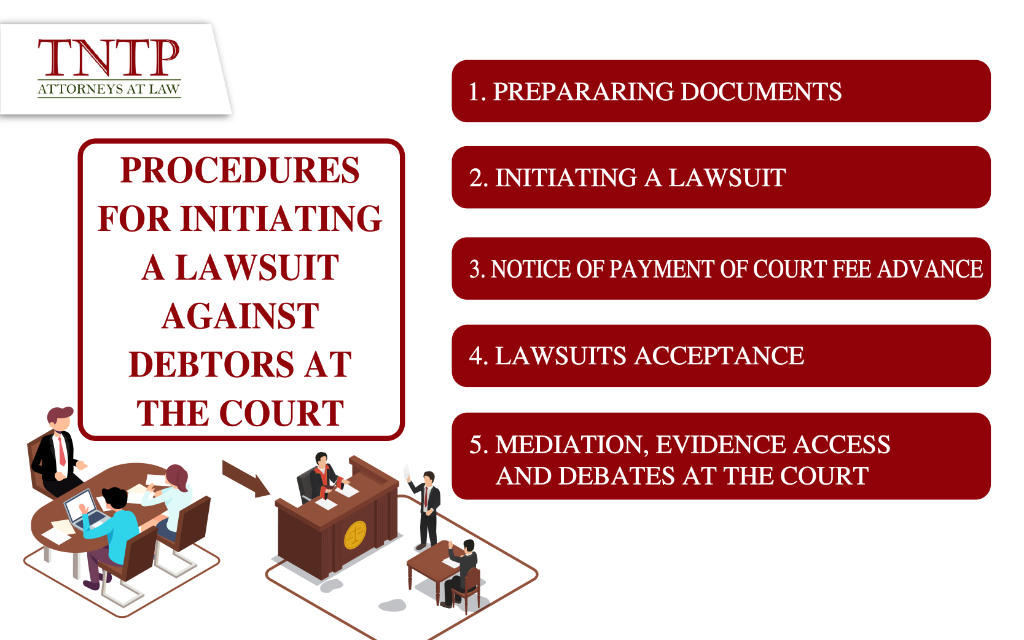Procedures for initiating a lawsuit against debtors at the court

Proceeding with debt collection procedures are always challenging, especially in case the debtors are individuals as they are often unable to repay, or deliberately avoid making the payment. When you want to perform debt collection, despite having applied many methods but the debtor is still inactive and refuses to pay the debt, you can sue the debtor at a competent People’s Court. What is the specific procedure for initiating a lawsuit against the debtor at the Court?
1. Conditions for initiating a lawsuit at the Court
First, the dispute is still within the statute of limitations for lawsuits. According to the Code of Civil Procedure 2015, the statute of limitations for initiating a lawsuit is 02 years from the date the individual, agency, or organization should know that their lawful rights and interests are infringed. Previously, when the statute of limitations has expired, according to the Code of Civil Procedure 2005, you are still entitled to file a lawsuit at the Court for a property claim, which may still be accepted by the Court. However, according to the new Code of Civil Procedure, this procedure is no longer available. The court will still accept your petition for debt collection, but whether it will consider resolving or returning the file will depend on your explanation for the overdue statute of limitations.
Second, a lawsuit for debt collection must be initiated under the correct Court’s jurisdiction. The related parties have the right to initiate a lawsuit to request the District Court where the defendant resides or works to settle the case if neither the parties nor the disputed property is overseas and an overseas request for judicial assistance is not required. If the involved parties or the disputed assets are overseas or an overseas request for judicial assistance is required, the involved parties must request the Provincial Court where the defendant resides or works to initiate a lawsuit.
2. Procedures for initiating a lawsuit against debtors at the court
The petition file includes:
- Lawsuit petition form
- Documents and evidence to prove that the lawsuit claim is grounded and lawful (Debt papers/Loan contract and other documents)
- State agency’s certification of the defendant’s residential and working address
- If the plaintiff is an individual: A notarized copy of the plaintiff’s ID card or household registration book.
- If the plaintiff is an organization: Business registration license or establishment decision, operation license.
Initiating a lawsuit:
After the Court receives the petition file, the following tasks must be conducted:
- If it is the case of returning the lawsuit petition as prescribed in the Civil of Procedure Code, the Court shall return the lawsuit petition and attached documents/evidence to the plaintiff.
- If it is not the above case but the lawsuit petition is not following the prescribed form or does not have all the prescribed contents, the Court shall notify the plaintiff of required amendments and supplements within a fixed time limit.
- If all the conditions are met in accordance with regulations, the Court shall allow the plaintiff to advance the court fees within 15 days from the date of receipt of the notice.
Notice of payment of court fee advance
After accepting the valid lawsuit file, the court shall send a notice of court fee advance payment to the plaintiff. Within 07 days upon receipt of the court’s notice, the plaintiff must pay the court fee advances to the competent civil enforcement authorities.
Lawsuits acceptance
After the plaintiff pays the court fees in advance, he/she will receive a corresponding receipt of payment from the competent civil enforcement authorities. Accordingly, the court will issue a notice of acceptance when the receipt for court fees advance payment is submitted by the plaintiff.
Mediation, evidence access and debates at the Court
After accepting the case, the Court will hold meetings for mediation and disclosure of evidence within 2-3 months from the date of acceptance. If the mediation is unsuccessful during this period, the Court will proceed to bring the case to trial and notify the trial schedule to the plaintiffs.
Above is an article that guides the procedure and related documents for initiating a lawsuit against the debtor at the Court. Hopefully, through this article, TNTP can equip you with a better understanding of the procedures for initiating a lawsuit against the debtor at the Court, thereby, you may decide on the appropriate form of debt collection.
Sincerely,


